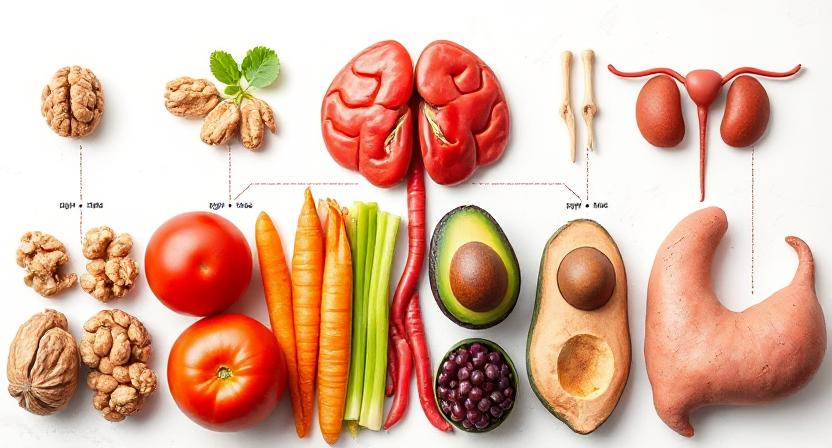

Food Is Medicine: How Nature Designed Foods to Support Specific Organs


Arya Soleil
The saying “you are what you eat” has never been more accurate. Ancient cultures, modern science, and emerging nutritional wisdom all point to one truth: food is not just fuel—it’s information. And sometimes, that information is visually encoded into the food itself. Nature provides subtle clues through the shape, color, and texture of foods, often resembling the organs they nourish. This idea, often called the “Doctrine of Signatures,” has long fascinated herbalists and holistic health practitioners. In this blog, we’ll explore how certain foods support specific body parts—right down to how they visually mimic the organs they benefit.
Avocado and the Uterus
Slice open an avocado and you’ll see a striking resemblance to the female uterus. Avocados are rich in healthy fats, folate, and vitamin E—all of which support hormone regulation, cervical health, and fertility. Folate, in particular, is crucial during pregnancy for fetal development. Interestingly, it takes exactly nine months for an avocado to grow from blossom to ripe fruit. Coincidence? Perhaps not. Avocados also contain phytonutrients that help balance estrogen levels, making them essential for female reproductive health.
Tomato and the Heart
Cut open a tomato and you’ll see multiple chambers, a deep red color, and a vascular-like structure that mimics the human heart. Tomatoes are packed with lycopene, a powerful antioxidant that helps reduce oxidative stress and inflammation in the cardiovascular system. Regular consumption of tomatoes has been linked to lower cholesterol levels, reduced arterial plaque, and improved blood vessel function. Whether raw in salads or cooked into sauces, tomatoes are a heart-healthy staple.
Ginger and the Digestive Tract
With its knobby appearance and root-like shape, ginger mirrors the curves and ridges of the stomach and intestines. Ginger has been used for centuries to treat nausea, indigestion, and gastrointestinal discomfort. Its active compound, gingerol, has anti-inflammatory properties that calm the digestive tract and stimulate bile production, improving nutrient absorption and easing bloating. A cup of ginger tea is often all it takes to soothe an upset stomach.
Ginseng and the Veins
Ginseng roots resemble tiny human figures with sprawling limbs, mimicking the circulatory system. Known as a natural adaptogen, ginseng enhances circulation and reduces fatigue by increasing nitric oxide production, which relaxes blood vessels. This not only improves blood flow but also supports the vascular system’s overall health. Ginseng also helps regulate blood sugar levels and boosts stamina, making it an ally for both heart and vein health.
Celery and the Bones
Celery stalks look uncannily like bones—and they’re good for them too. High in silicon and vitamin K, celery helps strengthen bones and connective tissues. Silicon plays a crucial role in bone mineralization and repair, while vitamin K is essential for calcium metabolism. The sodium content in celery also mirrors the sodium makeup of our bones, making it a naturally balancing food for skeletal support.
Onion and Cell Health
Peel an onion and you’ll see translucent layers that resemble cell membranes. Onions are rich in sulfur-containing compounds like quercetin, which support cellular detoxification, reduce inflammation, and act as antioxidants. These compounds help neutralize free radicals, support DNA integrity, and play a role in preventing cellular mutations that can lead to chronic disease. Eating raw onion in moderation can offer powerful cellular protection.
Walnut and the Brain
A shelled walnut looks remarkably like the human brain—complete with left and right hemispheres, wrinkles, and a cerebellum. Walnuts are a brain-boosting superfood, rich in omega-3 fatty acids, polyphenols, and vitamin E. These nutrients support memory, cognitive performance, and the formation of neurotransmitters. Regular walnut consumption is associated with improved brain function and a reduced risk of neurodegenerative diseases like Alzheimer’s.
Citrus and the Breasts
Citrus fruits like oranges and grapefruits resemble mammary glands in structure, and they play a protective role too. They are rich in limonoids and vitamin C, both of which act as antioxidants and detoxifiers. Limonoids have been studied for their potential to inhibit the development of breast cancer cells. Vitamin C also supports collagen production, skin elasticity, and immune function—all critical to breast tissue health.
Broccoli and Anti-Cancer Properties
Broccoli resembles the microscopic image of a cancer cell—but unlike cancer, it’s a fighter, not a foe. This cruciferous vegetable is a powerful anti-cancer food. It contains sulforaphane, a compound shown to neutralize carcinogens and support the body’s detoxification pathways. Broccoli also provides indole-3-carbinol, which helps regulate estrogen metabolism and reduce the risk of hormone-related cancers.
Figs and the Scrotum
Figs, when sliced open, resemble the testes. In fact, studies suggest that figs may enhance male fertility by increasing sperm count and motility. They are rich in antioxidants, fiber, and minerals like magnesium and zinc, all of which support reproductive health. The seeds inside a fig symbolize the potential for fertility, and traditionally, figs have been used to treat sexual dysfunction.
Grapes and the Lungs
Grapes grow in clusters that mirror the structure of the alveoli in the lungs. Their skins contain resveratrol, an antioxidant known to reduce inflammation and protect lung tissue from environmental toxins like pollution and cigarette smoke. Grapes also contain flavonoids that support capillary function and reduce bronchial inflammation. Incorporating grapes into your diet may help improve lung capacity and resilience.
Mushrooms and the Ears
A sliced mushroom bears a resemblance to the human ear. Mushrooms are rich in vitamin D, which is essential for bone and ear health, including the tiny bones in the ear that aid in hearing. They also contain selenium and potassium, which play a role in maintaining nerve function and inner ear balance. Including mushrooms in your meals may support auditory function and help prevent age-related hearing loss.
Carrots and the Eyes
It’s no surprise that the concentric rings in a carrot slice resemble the human eye. Carrots are high in beta-carotene, a precursor to vitamin A, which is crucial for maintaining healthy vision. Vitamin A supports the retina’s function and helps prevent night blindness and age-related macular degeneration. Snacking on raw carrots or adding them to stews and juices supports eye health naturally.
Rhubarb and the Bones
With its long, sturdy stalks, rhubarb visually mimics the structure of bones. Rhubarb is high in calcium and vitamin K—both of which are necessary for bone strength and density. Its antioxidant content also helps reduce inflammation that can contribute to bone degradation. Incorporating rhubarb into your diet may help maintain skeletal health, especially as you age.
Kidney Beans and the Kidneys
Kidney beans are perhaps the most visually obvious of all—shaped exactly like the organ they benefit. Rich in fiber, protein, and various micronutrients, kidney beans support detoxification and renal function. They help regulate blood sugar levels and reduce the risk of kidney damage due to high blood pressure or diabetes. Soaking and cooking them properly is essential to remove naturally occurring toxins.
Holistic Nutrition: More Than Just a Trend
The idea that nature hints at the purpose of each plant or food may sound poetic, but emerging research continues to support these traditional insights. Whole foods are incredibly complex systems of vitamins, minerals, enzymes, fiber, and phytochemicals—all of which work synergistically to support human health.
Eating real, unprocessed foods that closely resemble their natural state maximizes their nutritional power and healing potential. Our modern diets, high in processed and synthetic ingredients, often lack this intelligence. By going back to nature, we reconnect not only with our roots but also with the wisdom embedded in the food itself.
Practical Tips for Implementing Food-Organ Pairing
If you’re inspired to align your diet more closely with your body’s needs, consider these simple steps:
- Eat the Rainbow: Each color in fruits and vegetables reflects a different set of phytonutrients. A diverse plate supports every organ system.
- Shop Smart: Buy whole foods instead of packages. The more a food looks like it did in nature, the better.
- Cook Simply: Preserve nutrients by steaming, lightly sautéing, or eating raw when appropriate.
- Mind Your Portions: Nutrient density is more important than calorie counting. Focus on quality, not just quantity.
- Connect With Your Body: Pay attention to how you feel after eating certain foods. Your body gives subtle feedback when something is nourishing or depleting.
Conclusion: Let Food Be Your Everyday Medicine
The foods you choose every day either fight disease or feed it. When we begin to see our meals as tools for healing and nourishment—not just as fuel—we step into a deeper relationship with health. Nature doesn’t just feed us. It teaches us. And if we pay close enough attention, it even shows us the way—organ by organ, bite by bite. So the next time you slice into a tomato, snack on a walnut, or steam a bunch of broccoli, remember: you’re not just eating food. You’re aligning with medicine designed by the Earth itself.
Recommended Reads

- June 9, 2025
Castor Oil in the Navel: A Forgotten Practice That Supports Digestion and Sleep
Home News Healthy Habits & Lifestyle Health Conditions &...


- June 9, 2025
Turmeric for Ulcers: A Natural Way to Soothe and Protect Your Stomach
Home News Healthy Habits & Lifestyle Health Conditions &...


- June 9, 2025
The Healing Power of Castor Oil Compresses: A Natural Therapy for Detox, Sleep, and Circulation
Home News Healthy Habits & Lifestyle Health Conditions &...


- June 9, 2025
Medicinal Mushrooms: Ancient Remedies with Modern Benefits
Home News Healthy Habits & Lifestyle Health Conditions &...


- June 9, 2025
Triphala: The Ancient Herbal Blend That Supports Digestion, Detox, and Longevity
Home News Healthy Habits & Lifestyle Health Conditions &...


- June 9, 2025
Mullein: Herbal Support for Lung Health and Clear Breathing
Home News Healthy Habits & Lifestyle Health Conditions &...

Food Is Medicine: How Nature Designed Foods to Support Specific Organs

The saying “you are what you eat” has never been more accurate. Ancient cultures, modern science, and emerging nutritional wisdom all point to one truth: food is not just fuel—it’s information. And sometimes, that information is visually encoded into the food itself. Nature provides subtle clues through the shape, color, and texture of foods, often resembling the organs they nourish. This idea, often called the “Doctrine of Signatures,” has long fascinated herbalists and holistic health practitioners. In this blog, we’ll explore how certain foods support specific body parts—right down to how they visually mimic the organs they benefit.
Avocado and the Uterus
Slice open an avocado and you’ll see a striking resemblance to the female uterus. Avocados are rich in healthy fats, folate, and vitamin E—all of which support hormone regulation, cervical health, and fertility. Folate, in particular, is crucial during pregnancy for fetal development. Interestingly, it takes exactly nine months for an avocado to grow from blossom to ripe fruit. Coincidence? Perhaps not. Avocados also contain phytonutrients that help balance estrogen levels, making them essential for female reproductive health.
Tomato and the Heart
Cut open a tomato and you’ll see multiple chambers, a deep red color, and a vascular-like structure that mimics the human heart. Tomatoes are packed with lycopene, a powerful antioxidant that helps reduce oxidative stress and inflammation in the cardiovascular system. Regular consumption of tomatoes has been linked to lower cholesterol levels, reduced arterial plaque, and improved blood vessel function. Whether raw in salads or cooked into sauces, tomatoes are a heart-healthy staple.
Ginger and the Digestive Tract
With its knobby appearance and root-like shape, ginger mirrors the curves and ridges of the stomach and intestines. Ginger has been used for centuries to treat nausea, indigestion, and gastrointestinal discomfort. Its active compound, gingerol, has anti-inflammatory properties that calm the digestive tract and stimulate bile production, improving nutrient absorption and easing bloating. A cup of ginger tea is often all it takes to soothe an upset stomach.
Ginseng and the Veins
Ginseng roots resemble tiny human figures with sprawling limbs, mimicking the circulatory system. Known as a natural adaptogen, ginseng enhances circulation and reduces fatigue by increasing nitric oxide production, which relaxes blood vessels. This not only improves blood flow but also supports the vascular system’s overall health. Ginseng also helps regulate blood sugar levels and boosts stamina, making it an ally for both heart and vein health.
Celery and the Bones
Celery stalks look uncannily like bones—and they’re good for them too. High in silicon and vitamin K, celery helps strengthen bones and connective tissues. Silicon plays a crucial role in bone mineralization and repair, while vitamin K is essential for calcium metabolism. The sodium content in celery also mirrors the sodium makeup of our bones, making it a naturally balancing food for skeletal support.
Onion and Cell Health
Peel an onion and you’ll see translucent layers that resemble cell membranes. Onions are rich in sulfur-containing compounds like quercetin, which support cellular detoxification, reduce inflammation, and act as antioxidants. These compounds help neutralize free radicals, support DNA integrity, and play a role in preventing cellular mutations that can lead to chronic disease. Eating raw onion in moderation can offer powerful cellular protection.
Walnut and the Brain
A shelled walnut looks remarkably like the human brain—complete with left and right hemispheres, wrinkles, and a cerebellum. Walnuts are a brain-boosting superfood, rich in omega-3 fatty acids, polyphenols, and vitamin E. These nutrients support memory, cognitive performance, and the formation of neurotransmitters. Regular walnut consumption is associated with improved brain function and a reduced risk of neurodegenerative diseases like Alzheimer’s.
Citrus and the Breasts
Citrus fruits like oranges and grapefruits resemble mammary glands in structure, and they play a protective role too. They are rich in limonoids and vitamin C, both of which act as antioxidants and detoxifiers. Limonoids have been studied for their potential to inhibit the development of breast cancer cells. Vitamin C also supports collagen production, skin elasticity, and immune function—all critical to breast tissue health.
Broccoli and Anti-Cancer Properties
Broccoli resembles the microscopic image of a cancer cell—but unlike cancer, it’s a fighter, not a foe. This cruciferous vegetable is a powerful anti-cancer food. It contains sulforaphane, a compound shown to neutralize carcinogens and support the body’s detoxification pathways. Broccoli also provides indole-3-carbinol, which helps regulate estrogen metabolism and reduce the risk of hormone-related cancers.
Figs and the Scrotum
Figs, when sliced open, resemble the testes. In fact, studies suggest that figs may enhance male fertility by increasing sperm count and motility. They are rich in antioxidants, fiber, and minerals like magnesium and zinc, all of which support reproductive health. The seeds inside a fig symbolize the potential for fertility, and traditionally, figs have been used to treat sexual dysfunction.
Grapes and the Lungs
Grapes grow in clusters that mirror the structure of the alveoli in the lungs. Their skins contain resveratrol, an antioxidant known to reduce inflammation and protect lung tissue from environmental toxins like pollution and cigarette smoke. Grapes also contain flavonoids that support capillary function and reduce bronchial inflammation. Incorporating grapes into your diet may help improve lung capacity and resilience.
Mushrooms and the Ears
A sliced mushroom bears a resemblance to the human ear. Mushrooms are rich in vitamin D, which is essential for bone and ear health, including the tiny bones in the ear that aid in hearing. They also contain selenium and potassium, which play a role in maintaining nerve function and inner ear balance. Including mushrooms in your meals may support auditory function and help prevent age-related hearing loss.
Carrots and the Eyes
It’s no surprise that the concentric rings in a carrot slice resemble the human eye. Carrots are high in beta-carotene, a precursor to vitamin A, which is crucial for maintaining healthy vision. Vitamin A supports the retina’s function and helps prevent night blindness and age-related macular degeneration. Snacking on raw carrots or adding them to stews and juices supports eye health naturally.
Rhubarb and the Bones
With its long, sturdy stalks, rhubarb visually mimics the structure of bones. Rhubarb is high in calcium and vitamin K—both of which are necessary for bone strength and density. Its antioxidant content also helps reduce inflammation that can contribute to bone degradation. Incorporating rhubarb into your diet may help maintain skeletal health, especially as you age.
Kidney Beans and the Kidneys
Kidney beans are perhaps the most visually obvious of all—shaped exactly like the organ they benefit. Rich in fiber, protein, and various micronutrients, kidney beans support detoxification and renal function. They help regulate blood sugar levels and reduce the risk of kidney damage due to high blood pressure or diabetes. Soaking and cooking them properly is essential to remove naturally occurring toxins.
Holistic Nutrition: More Than Just a Trend
The idea that nature hints at the purpose of each plant or food may sound poetic, but emerging research continues to support these traditional insights. Whole foods are incredibly complex systems of vitamins, minerals, enzymes, fiber, and phytochemicals—all of which work synergistically to support human health.
Eating real, unprocessed foods that closely resemble their natural state maximizes their nutritional power and healing potential. Our modern diets, high in processed and synthetic ingredients, often lack this intelligence. By going back to nature, we reconnect not only with our roots but also with the wisdom embedded in the food itself.
Practical Tips for Implementing Food-Organ Pairing
If you’re inspired to align your diet more closely with your body’s needs, consider these simple steps:
- Eat the Rainbow: Each color in fruits and vegetables reflects a different set of phytonutrients. A diverse plate supports every organ system.
- Shop Smart: Buy whole foods instead of packages. The more a food looks like it did in nature, the better.
- Cook Simply: Preserve nutrients by steaming, lightly sautéing, or eating raw when appropriate.
- Mind Your Portions: Nutrient density is more important than calorie counting. Focus on quality, not just quantity.
- Connect With Your Body: Pay attention to how you feel after eating certain foods. Your body gives subtle feedback when something is nourishing or depleting.
Conclusion: Let Food Be Your Everyday Medicine
The foods you choose every day either fight disease or feed it. When we begin to see our meals as tools for healing and nourishment—not just as fuel—we step into a deeper relationship with health. Nature doesn’t just feed us. It teaches us. And if we pay close enough attention, it even shows us the way—organ by organ, bite by bite. So the next time you slice into a tomato, snack on a walnut, or steam a bunch of broccoli, remember: you’re not just eating food. You’re aligning with medicine designed by the Earth itself.
Recommended Reads

- June 9, 2025
Castor Oil in the Navel: A Forgotten Practice That Supports Digestion and Sleep
Home News Healthy Habits & Lifestyle Health Conditions &...


- June 9, 2025
Turmeric for Ulcers: A Natural Way to Soothe and Protect Your Stomach
Home News Healthy Habits & Lifestyle Health Conditions &...


- June 9, 2025
The Healing Power of Castor Oil Compresses: A Natural Therapy for Detox, Sleep, and Circulation
Home News Healthy Habits & Lifestyle Health Conditions &...


- June 9, 2025
Medicinal Mushrooms: Ancient Remedies with Modern Benefits
Home News Healthy Habits & Lifestyle Health Conditions &...


- June 9, 2025
Triphala: The Ancient Herbal Blend That Supports Digestion, Detox, and Longevity
Home News Healthy Habits & Lifestyle Health Conditions &...


- June 9, 2025
Mullein: Herbal Support for Lung Health and Clear Breathing
Home News Healthy Habits & Lifestyle Health Conditions &...



